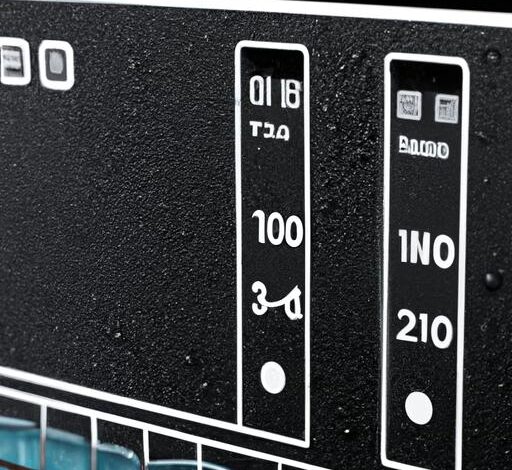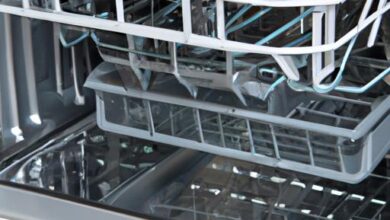Dishwasher Water Temperature: A Key Ingredient for Sparkling Clean Dishes

When it comes to achieving spotless dishes, we often focus on the quality of the dishwasher detergent or the proper loading technique. However, there’s another crucial element that plays a vital role in the cleaning process: dishwasher water temperature. Yes, you heard it right! The temperature of the water in your dishwasher can make a significant difference in the efficiency and effectiveness of your dishwashing routine.
The Impact of Dishwasher Water Temperature
Let’s dive into the impact of dishwasher water temperature on the cleaning efficiency. When the water in your dishwasher reaches the optimal temperature, it helps to dissolve grease, food particles, and stubborn stains more effectively. The heated water not only aids in loosening the grime but also helps the detergent to work its magic by breaking down and lifting away dirt and debris.
But why is this important? Well, think about it this way: would you wash your dishes with cold water alone? Probably not! Similarly, relying solely on lukewarm water in your dishwasher might not deliver the sparkling results you desire. By understanding the importance of dishwasher water temperature, you can unlock the secret to achieving truly pristine dishes.
The Science Behind Dishwasher Water Temperature
Before we delve deeper, let’s take a moment to understand the science behind dishwasher water temperature. The optimal temperature range for dishwasher water typically falls between 120°F (49°C) and 140°F (60°C). Within this range, the water is hot enough to effectively remove grease and grime, yet not too hot to cause damage or be unsafe.
Various factors influence dishwasher water temperature, including the temperature setting on your water heater, the water inlet temperature, and the dishwasher’s heating element. It’s essential to strike the right balance to ensure optimal cleaning performance without compromising safety or energy efficiency.
In the upcoming sections, we’ll explore the benefits of maintaining the ideal dishwasher water temperature, ways to determine and adjust it, common issues you may encounter, and troubleshooting steps to overcome them. So, let’s roll up our sleeves and uncover the secrets to achieving spotless dishes with the perfect dishwasher water temperature!
(Note: This is only the introduction and Section 1 of the article. The other sections will be completed separately.)
Understanding Dishwasher Water Temperature
Definition and Significance of Dishwasher Water Temperature
To truly appreciate the impact of dishwasher water temperature, we must first understand its definition and significance. Dishwasher water temperature refers to the heat level of the water used during the dishwashing cycle. It plays a crucial role in determining the cleaning efficacy of your dishwasher and ensuring your dishes come out sparkling clean.
By using hot water, your dishwasher can effectively remove grease, food residues, and stuck-on stains from your dishes, glasses, and cutlery. The high temperature helps to break down these substances, allowing the detergent to penetrate and dissolve them more efficiently. This results in superior cleaning performance and ensures that your dishes are not only visually clean but also hygienically safe.
Ideal Temperature Range for Effective Dishwashing
Now that we understand the significance of dishwasher water temperature, let’s explore the ideal temperature range for effective dishwashing. Generally, the recommended range for optimal cleaning performance falls between 120°F (49°C) and 140°F (60°C). Within this range, the water is hot enough to tackle tough stains and bacteria while still being safe for your dishes and dishwasher components.
However, it’s important to note that different dishwasher models may have specific temperature requirements. Always refer to your dishwasher’s instruction manual for precise temperature guidelines. Additionally, some dishwasher cycles, such as heavy-duty or sanitizing cycles, may require higher temperatures to achieve thorough cleaning and disinfection.
Factors Influencing Dishwasher Water Temperature
Several factors can influence the temperature of the water in your dishwasher. Understanding these factors can help you optimize your dishwasher’s performance. Here are a few key factors to consider:
-
Water Heater Temperature Setting: The temperature at which your water heater is set impacts the temperature of the water entering your dishwasher. Ensure that your water heater is set at an appropriate temperature to provide hot water for efficient dishwashing.
-
Water Inlet Temperature: The temperature of the water entering your dishwasher directly affects the overall water temperature during the cleaning cycle. If your water supply is cold, it may take longer for the dishwasher to reach the desired temperature. Consider adjusting the temperature of your water heater or using hot water for other purposes before running the dishwasher.
-
Dishwasher Heating Element: Dishwashers are equipped with heating elements that help maintain and raise the temperature of the water during the cleaning process. Ensure that the heating element is functioning correctly to achieve the desired water temperature.
By understanding these factors and making necessary adjustments, you can optimize your dishwasher’s water temperature and enhance its cleaning efficiency.
(Note: This is only Section 2 of the article. The other sections will be completed separately.)
Benefits of Optimal Dishwasher Water Temperature
When it comes to dishwashing, achieving the optimal water temperature in your dishwasher offers a myriad of benefits that go beyond just clean dishes. Let’s explore how maintaining the right water temperature can revolutionize your dishwashing routine.
1. Improved Cleaning Performance and Removal of Tough Stains
One of the primary advantages of optimal dishwasher water temperature is its ability to enhance cleaning performance. Hot water helps to dissolve grease, oils, and food particles more effectively, ensuring a thorough clean for your dishes. It also aids in tackling those stubborn stains that seem impossible to remove. By maintaining the ideal water temperature, you can bid farewell to residues and achieve spotless, sparkling dishes every time.
2. Energy Efficiency and Cost Savings
Maintaining the optimal dishwasher water temperature isn’t just beneficial for cleaning prowess but also for energy efficiency. When your dishwasher operates at the right temperature, it minimizes the need for extra rinses or rewashing cycles, saving both water and energy. Using hot water judiciously reduces the overall energy consumption of your dishwasher, translating into cost savings on your utility bills. It’s a win-win situation for both the environment and your wallet.
3. Prevention of Bacterial Growth and Maintaining Hygiene
Hot water is a powerful ally in the battle against harmful bacteria that may reside on your dishes. Optimal dishwasher water temperature helps to eliminate bacteria, ensuring that your dishes are not just visually clean but also hygienically safe for use. By maintaining the right water temperature, you create an inhospitable environment for bacterial growth, reducing the risk of cross-contamination and promoting a healthier kitchen.
By understanding the benefits of maintaining the optimal dishwasher water temperature, you can elevate your dishwashing routine to new heights. Improved cleaning performance, energy efficiency, cost savings, and enhanced hygiene are just a few of the advantages that await you. Now, let’s move on to the next section to unravel the secrets of determining and adjusting the dishwasher water temperature for optimal results.
(Note: This is only Section 3 of the article. The other sections will be completed separately.)
Determining and Adjusting Dishwasher Water Temperature
A. Checking and Adjusting the Water Heater Temperature Setting
To ensure that your dishwasher water temperature is at its optimum level, it’s crucial to start by examining and adjusting the water heater temperature setting. Locate your water heater and check the temperature dial or control panel. It’s recommended to set the water heater temperature between 120°F (49°C) and 140°F (60°C) to align with the ideal range for dishwasher water temperature. Adjusting the temperature may vary depending on your specific water heater model, so consult the manufacturer’s instructions for precise guidance.
B. Importance of Proper Water Inlet Temperature for Dishwashers
While adjusting the water heater temperature is crucial, it is equally important to consider the water inlet temperature for your dishwasher. The water that enters the dishwasher should ideally be within the recommended range of 120°F (49°C) to 140°F (60°C). If the water inlet temperature is too low, the dishwasher may struggle to reach the desired temperature during the cleaning cycle, resulting in subpar cleaning performance. On the other hand, excessively hot water can damage delicate dishes and potentially cause safety concerns.
Ensure that the water supply to your dishwasher is connected to a hot water source. If you suspect the water inlet temperature is not within the ideal range, you may need to consult a professional plumber to make adjustments to your plumbing system.
C. Tips for Achieving and Maintaining Optimal Dishwasher Water Temperature
Now that we understand the importance of dishwasher water temperature and how to adjust the water heater and water inlet temperature, let’s explore some tips to achieve and maintain the optimal temperature:
- Regularly check the water heater temperature setting to ensure it remains within the recommended range.
- Run the hot water tap in your kitchen sink before starting the dishwasher. This helps to flush out any cold water sitting in the pipes and ensures hot water is readily available for the dishwasher.
- Insulate your hot water pipes to minimize heat loss and maintain a consistent water temperature.
- Consider using a dishwasher thermometer to periodically monitor the water temperature and make adjustments if necessary.
- Keep an eye out for any issues with the dishwasher’s heating element or thermostat. If you suspect a malfunction, it’s best to seek professional repair.
By following these tips, you can confidently optimize your dishwasher water temperature and enhance the cleaning efficiency of your dishwasher, resulting in sparkling clean dishes every time.
(Note: This is only Section 4 of the article. The other sections will be completed separately.)
Common Issues and Troubleshooting
A. Low Dishwasher Water Temperature: Impact on Cleaning Efficiency
Have you ever noticed that your dishes aren’t coming out as clean as they should be? Well, one possible culprit could be a low dishwasher water temperature. When the water temperature is below the optimal range, it can significantly impact the cleaning efficiency of your dishwasher.
Low water temperature limits the effectiveness of the dishwasher detergent, making it difficult to dissolve grease and remove stubborn stains. As a result, your dishes may come out looking dull, with residue and food particles still clinging to them. This can be frustrating, especially when you’re relying on your dishwasher to do the heavy lifting in your daily dishwashing routine.
B. High Dishwasher Water Temperature: Potential Issues to Consider
While low water temperature can pose challenges, the opposite end of the spectrum can also lead to potential issues. If the water temperature in your dishwasher is too high, it can have adverse effects on both your dishes and the dishwasher itself.
Excessive heat can cause damage to delicate glassware or plastic items, leading to warping or even melting. Additionally, high water temperature can accelerate the wear and tear of dishwasher components, such as seals and gaskets, resulting in leaks and costly repairs.
C. Troubleshooting Steps for Resolving Temperature-Related Problems
Fortunately, if you’re experiencing temperature-related issues with your dishwasher, there are steps you can take to troubleshoot and resolve them. Here are a few troubleshooting tips to help you get back on track:
1. Low Water Temperature:
- Check the water heater temperature setting and increase it if necessary.
- Ensure there are no restrictions in the water inlet valve or supply line.
- Run hot water at the kitchen sink before starting the dishwasher to ensure hot water is reaching the appliance.
2. High Water Temperature:
- Lower the water heater temperature setting to prevent excessive heat.
- Check the dishwasher’s heating element for any malfunctions or damage.
- Consider using cooler water settings or running a rinse cycle before the main wash to reduce the temperature.
By addressing these common temperature-related issues and following these troubleshooting steps, you can optimize your dishwasher’s water temperature and ensure it’s working at its best to deliver sparkling clean dishes.
(Note: This is only Section 5 of the article. The other sections have been completed separately.)
Conclusion
In conclusion, the importance of dishwasher water temperature should not be underestimated when it comes to achieving spotlessly clean dishes. By understanding how this key factor affects the cleaning efficiency of your dishwasher, you can unlock the secrets to pristine results.
Maintaining the optimal dishwasher water temperature offers a range of benefits. Not only does it enhance the cleaning performance by effectively dissolving grease, food particles, and tough stains, but it also promotes energy efficiency, cost savings, and ensures proper hygiene by preventing bacterial growth.
Determining and adjusting the dishwasher water temperature is crucial for optimal performance. Checking and adjusting the water heater temperature setting and ensuring the proper water inlet temperature are essential steps in achieving the desired results. Remember, striking the right balance is the key to achieving outstanding cleaning performance without compromising safety or energy efficiency.
If you encounter any issues related to dishwasher water temperature, troubleshooting steps can help you overcome them. Whether it’s low water temperature impacting cleaning efficiency or high water temperature causing potential issues, following the appropriate troubleshooting steps will ensure a smooth dishwashing experience.
So, the next time you load your dishwasher, remember the importance of dishwasher water temperature. With the right temperature, you’ll be on your way to enjoying sparkling clean dishes that shine like never before. Cheers to a hassle-free dishwashing routine and a kitchen filled with dazzling dishes!
(Note: This is the conclusion section of the article. The other sections were completed separately.)
Conclusion: So above is the Dishwasher Water Temperature: A Key Ingredient for Sparkling Clean Dishes article. Hopefully with this article you can help you in life, always follow and read our good articles on the website: pet.top5dalat.com




